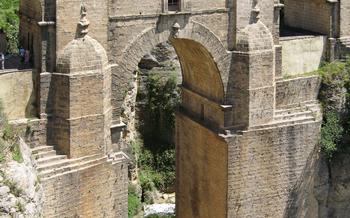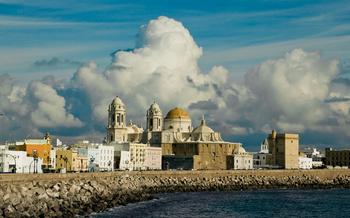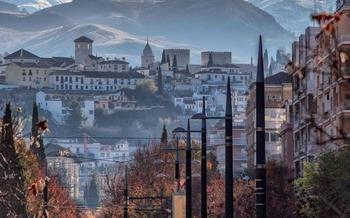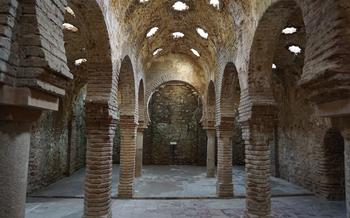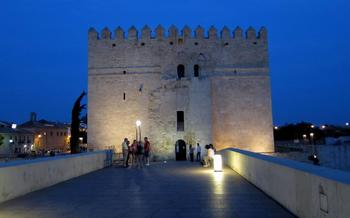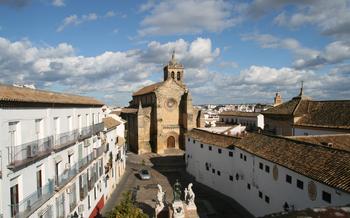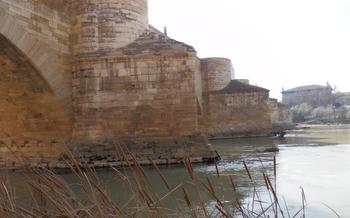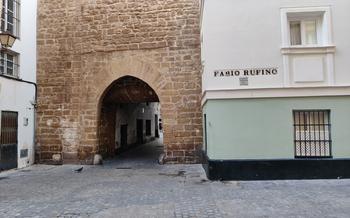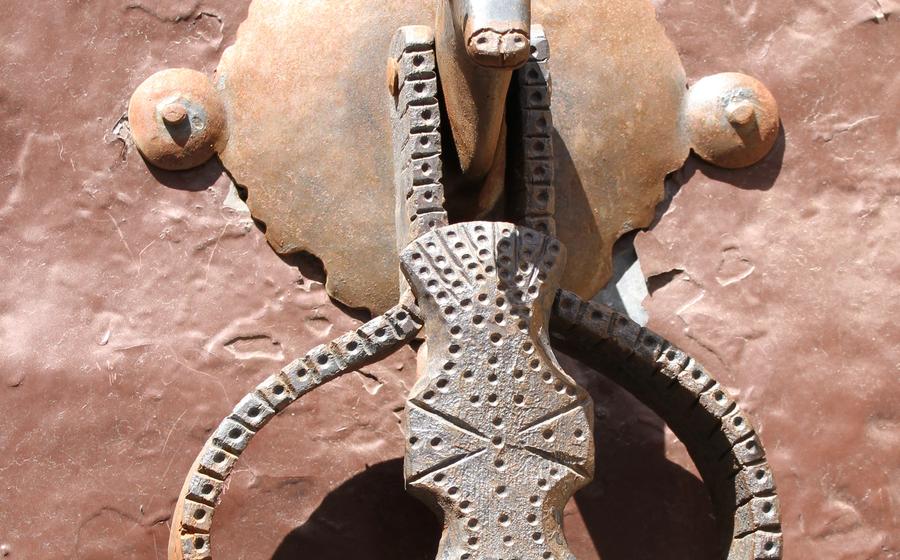
Ronda Bullring
- The Ronda Bullring: A Monumental Spectacle
- History and Significance
- Architectural Features
- Bullfighting Traditions
- Cultural Importance
- Stepping into the Arena: A Guided Tour
- The Corrida de Goyesca: A Unique Experience
- The Bullfighting Museum: A Journey Through History
- The Plaza de Toros: A Symbol of Ronda
- Beyond the Bullring: Exploring Ronda
- Safety at the Bullring: Ensuring a Positive Experience
- Dress Code and Etiquette: A Touch of Elegance
- Capturing the Moment: Photography and Videography
- Local Cuisine and Delicacies: A Taste of Ronda
- Souvenirs and Mementos: A Piece of Ronda
- Language and Communication: Bridging the Gap
- Accessibility for All: Ensuring Inclusivity
- Insider Tip: The Best Views
The Ronda Bullring: A Monumental Spectacle
In the heart of Andalusia, Spain, the historic city of Ronda is renowned for its iconic Plaza de Toros, or bullring. Constructed in 1785, the Ronda Bullring is not just an architectural marvel but also a symbol of Spanish heritage and the controversial tradition of bullfighting.
History and Significance
The Ronda Bullring is one of the oldest and most significant bullrings in Spain. Its construction was initiated in 1785 and completed in 1790, making it one of the first bullrings built in the country. The bullring has witnessed countless bullfights and has played a pivotal role in shaping the history of Spanish bullfighting.
Architectural Features
The Ronda Bullring is an architectural masterpiece, showcasing a unique design that blends Moorish and Baroque influences. The circular structure features two tiers of arcades, with 68 arches on the lower level and 56 on the upper level. Above the arcades, a sloping roof covered with Arabic tiles completes the bullring's distinctive appearance.
Bullfighting Traditions
Bullfighting, or tauromaquia, is a traditional spectacle in Spain that involves a matador, or bullfighter, facing a bull in a choreographed performance. The matador's goal is to subdue the bull using a series of passes with a cape and banderillas, before delivering the final blow with a sword.
Cultural Importance
Bullfighting is deeply embedded in Spanish culture and heritage. It is considered an art form, with the matadors being revered as heroes. The Ronda Bullring has played a significant role in preserving and promoting this tradition, attracting thousands of visitors each year who come to witness the spectacle of bullfighting.
Stepping into the Arena: A Guided Tour
Embark on a captivating guided tour of the Ronda Bullring and delve into the secrets of bullfighting, a tradition deeply rooted in Spanish culture. Explore the bullring's interior, including the stables where the bulls are kept, the toril where they are released, and the enfermería, where injured matadors receive medical attention.
Uncover the intricacies of bullfighting techniques as you learn about the roles of each participant. Discover how the matador, the star of the show, skillfully maneuvers the bull with his capote, a colorful cape, and muleta, a red cloth. Witness the bravery of the banderilleros as they place banderillas, barbed sticks, into the bull's shoulders, and the precision of the picadors as they weaken the bull's neck muscles with their lances.
To enhance your understanding of the bullfight, participate in a simulated demonstration. Watch as experienced bullfighters showcase their skills, allowing you to grasp the techniques and strategies employed during a real bullfight. This immersive experience will provide a deeper appreciation for the art of tauromaquia, the bullfighting tradition that has captivated Spain for centuries.
The Corrida de Goyesca: A Unique Experience
Originating in 1954, the Corrida de Goyesca is an extraordinary bullfight event in Ronda, paying homage to the renowned Spanish painter, Francisco Goya. The bullfight takes place in the historic Plaza de Toros and is renowned for its spectacular display of artistry, tradition, and vibrant colors.
The matadors and their cuadrillas don elaborate costumes inspired by Goya's paintings, transforming the bullring into a living canvas. The atmosphere is electric, with spectators dressed in traditional Andalusian attire, creating a captivating spectacle that blends history, art, and the thrill of bullfighting.
Attending the Corrida de Goyesca is a unique opportunity to witness a fusion of Spanish culture, art, and tradition. It's an event that transports visitors to a different era, showcasing the grandeur and spectacle of bullfighting in its most artistic form.
Tips for Attending the Corrida de Goyesca:
- Book your tickets in advance to secure a spot in this highly sought-after event.
- Arrive early to soak up the pre-bullfight atmosphere and witness the parade of matadors and their cuadrillas in their colorful costumes.
- Dress in accordance with the event's formal dress code, which often includes traditional Andalusian attire for a truly immersive experience.
- Familiarize yourself with the bullfighting terminology and traditions to fully appreciate the spectacle.
- Be prepared for a long event, as the Corrida de Goyesca typically lasts for several hours.
- Respect the matadors, the bulls, and the traditions of bullfighting to ensure a positive and enjoyable experience for all.
The Bullfighting Museum: A Journey Through History
Nestled within the walls of the Ronda Bullring, the Bullfighting Museum offers a captivating journey through the rich history and traditions of bullfighting in Spain. As you step inside, you'll be transported back in time, surrounded by an array of artifacts, memorabilia, and exhibits that narrate the evolution of this controversial yet deeply rooted practice.
Discover the origins of bullfighting, tracing its roots back to ancient Iberian rituals and its transformation into a formalized spectacle during the Middle Ages. Admire a collection of intricately crafted bullfighting suits, each adorned with vibrant colors and elaborate embroidery, showcasing the artistry and craftsmanship associated with this unique attire.
Learn about the lives and legacies of legendary matadors, whose bravery and skill have etched their names in the annals of bullfighting history. Gaze upon their portraits, personal belongings, and the trophies they earned in the ring, gaining insights into their triumphs, rivalries, and the sacrifices they made in pursuit of glory.
The museum also delves into the controversial aspects of bullfighting, presenting a balanced perspective on the ethical debates surrounding the practice. Explore exhibits that highlight the arguments for and against bullfighting, showcasing the perspectives of animal rights activists, matadors, and the general public.
Through interactive displays, multimedia presentations, and guided tours, the Bullfighting Museum provides a comprehensive understanding of this complex and multifaceted tradition. Whether you're a seasoned aficionado or a curious visitor seeking to unravel the mysteries of bullfighting, this museum offers a profound and immersive experience that will leave a lasting impression.
The Plaza de Toros: A Symbol of Ronda
The Ronda Bullring, or Plaza de Toros, stands as a majestic symbol of Ronda, embodying the city's rich cultural heritage and deep connection to the art of bullfighting. Beyond its primary function as a venue for bullfighting events, the bullring has become an iconic landmark that attracts visitors from around the world.
The bullring's striking architecture and unique design make it a visual masterpiece. Its circular structure, with tiered seating rising from the arena floor, creates an intimate and immersive atmosphere for spectators. The exterior facade, adorned with intricate arches and decorative elements, reflects the Moorish and Renaissance influences that shaped Ronda's architectural identity.
The Plaza de Toros is not just a bullfighting arena; it is a living testament to Spanish culture and traditions. It has played a pivotal role in shaping Ronda's identity, attracting tourism, and showcasing the city's vibrant heritage. The bullring has become synonymous with Ronda, and its presence has contributed to the city's reputation as a cultural hub and a must-visit destination for travelers seeking authentic Spanish experiences.
As a symbol of Spanish pride and heritage, the Ronda Bullring stands tall, representing the enduring legacy of bullfighting in Spain. While the practice of bullfighting may be controversial, the bullring remains a powerful reminder of the deep cultural significance it holds for many Spaniards. The bullring serves as a stage where the traditions, rituals, and artistry of bullfighting are celebrated, showcasing the skills and bravery of the matadors.
Whether you are a passionate aficionado or simply curious about Spanish culture, the Ronda Bullring offers a unique opportunity to immerse yourself in the world of bullfighting and witness firsthand the spectacle that has captivated audiences for centuries.
Beyond the Bullring: Exploring Ronda
Beyond its iconic bullring, Ronda offers a wealth of attractions that showcase its rich history and stunning natural beauty. A must-visit landmark is the Puente Nuevo, a magnificent bridge that spans the El Tajo gorge. This architectural marvel offers breathtaking views of the surrounding countryside and is a popular spot for photography and sightseeing.
For a deeper dive into Ronda's past, visit the Museo de Ronda, which houses a collection of artifacts and exhibits that tell the story of the city's origins and development. The museum offers insights into Ronda's diverse heritage, from its Roman and Moorish roots to its role in the Reconquista.
To experience the vibrant atmosphere of Ronda, stroll through its charming streets, lined with whitewashed houses, traditional shops, and lively plazas. Indulge in the local cuisine at one of the many tapas bars or restaurants, savoring the region's specialties such as gazpacho (cold tomato soup) and pescaíto frito (fried fish).
Venturing beyond the city center, explore the surrounding countryside, which offers a variety of outdoor activities. Hike or bike through the picturesque Sierra de las Nieves mountain range, or take a refreshing dip in the natural pools of the Guadalhorce River.
To make the most of your trip, consider staying in one of Ronda's many charming hotels or guesthouses. Whether you prefer a luxurious stay at a historic palace or a cozy bed and breakfast, you'll find a range of accommodation options to suit your needs and budget.
Whether you're a history buff, an outdoor enthusiast, or simply seeking a taste of authentic Spanish culture, Ronda offers something for every traveler. Spend a few days exploring this captivating city, and you'll discover why it's one of Andalusia's most beloved destinations.
Safety at the Bullring: Ensuring a Positive Experience
Attending a bullfight involves following certain safety guidelines and protocols to ensure a positive and enjoyable experience. Firstly, it's crucial to be aware of the potential dangers associated with the event and to take appropriate precautions. The bullring is a confined space where bulls and matadors are in close proximity, so it's important to remain vigilant and avoid any actions that could put you at risk.
When choosing your seat, opt for one that provides a clear view of the bullring without being too close to the action. This will allow you to appreciate the spectacle while maintaining a safe distance from the bulls. Additionally, avoid standing up or moving around during the bullfight, as this can distract the matadors and increase the risk of accidents.
It's also important to be respectful of the matadors and the bullfighting tradition. Refrain from making loud noises or gestures that could disrupt the performance. Remember that bullfighting is a cultural event with deep-rooted traditions, and showing respect for the matadors and their craft is essential.
By following these safety tips and guidelines, you can ensure a safe and enjoyable experience at the Ronda Bullring, allowing you to fully immerse yourself in the spectacle of bullfighting while respecting the tradition and the safety of all involved.
Dress Code and Etiquette: A Touch of Elegance
Attending a bullfight in Ronda is not just about the spectacle in the arena; it's also about embracing the cultural traditions and etiquette associated with this unique event. Dressing appropriately shows respect for the matadors, the bullfighting tradition, and the local community.
For men, a smart casual attire is recommended. A lightweight suit in neutral tones, paired with a crisp white shirt and loafers or dress shoes, is a classic choice. Avoid shorts, t-shirts, and sportswear, as they are considered too casual for the occasion.
Women have more flexibility in their attire but should still aim for elegance and sophistication. A dress or skirt that falls below the knee, paired with a blouse or top, is a suitable option. Heels or wedges are preferred over flats or sneakers.
Accessorizing with a hat or scarf can add a touch of personal style while staying within the bounds of propriety. Remember, the goal is to dress respectfully and blend in with the local crowd.
Beyond attire, it's important to observe proper etiquette at the bullring. Applause and cheers are customary to show appreciation for the matadors' skills and bravery. However, avoid booing or heckling, as these are considered disrespectful.
Remain seated during the bullfight unless you need to use the restroom or purchase refreshments. Stand up only when the matador enters or leaves the arena or when the bull is released.
By following these simple guidelines, you can immerse yourself in the experience fully, showing respect for the tradition and the local culture while creating lasting memories of your visit to Ronda.
Capturing the Moment: Photography and Videography
Embracing the Art of Visual Storytelling
The Ronda Bullring presents a captivating spectacle that begs to be captured through the lens of a camera. However, it's essential to adhere to certain guidelines to ensure respect for the matadors, other attendees, and the overall bullfighting tradition.
Guidelines for Photography and Videography
-
Silent Mode: Maintain a respectful silence throughout the bullfight by keeping your phone or camera on silent mode.
-
Flash Photography: Avoid using flash photography, as it can be disruptive and distracting to the matadors and the bull.
-
Long-Range Lenses: Utilize long-range lenses to capture close-up shots while respecting the privacy of the matadors and other attendees.
-
No Selfies: Refrain from taking selfies during the bullfight as it can be distracting and disrespectful.
Tips for Stunning Captures
-
Composition: Experiment with different angles and compositions to create dynamic and visually appealing shots.
-
Timing: Be patient and wait for the opportune moment to capture the most impactful and dramatic scenes.
-
Lighting: Take advantage of the natural lighting to create beautiful and well-lit photographs.
Sharing Your Experiences
-
Social Media: Share your bullfighting experiences with the world through social media platforms, using relevant hashtags.
-
Travel Blogs: Create a travel blog to document your journey to Ronda and share your insights about the bullring.
-
Respectful Captions: Accompany your photos and videos with respectful and informative captions that provide context and insights.
Local Cuisine and Delicacies: A Taste of Ronda
Ronda offers a vibrant culinary scene that showcases the region's rich flavors and traditions. Before or after your bullfighting experience, indulge in a culinary journey that will tantalize your taste buds.
-
Tapas and Regional Dishes: Embark on a tapas crawl through Ronda's charming streets, savoring small plates of delectable bites. Try local specialties like "almendras fritas" (fried almonds), "ajo blanco" (cold almond soup), and "migas" (fried breadcrumbs with garlic and peppers).
-
Must-Try Local Specialties: Don't miss Ronda's signature dishes, such as "sopa de maimones" (gazpacho with rabbit meat), "cachola" (stewed oxtail), and "olla rondeña" (a hearty stew with chickpeas and pork).
-
Recommended Restaurants and Eateries: For an authentic dining experience, head to traditional restaurants near the bullring. Try "Casa Blas" for mouthwatering tapas, "El Lechuguita" for traditional Andalusian cuisine, and "Bar El Socorro" for a casual and lively atmosphere.
-
Tips for Savoring the Flavors: Remember to pair your meal with local wines from the Ronda region, known for its rich and fruity flavors. Don't forget to end your meal with a sweet treat, such as "bienmesabe" (almond cake) or "hojuelas" (fried pastries).
Souvenirs and Mementos: A Piece of Ronda
Souvenirs and Mementos: A Piece of Ronda
To cherish your memories of Ronda, consider taking home a souvenir or memento. The bullring area offers a variety of shops and stalls selling a diverse range of items. You can find traditional souvenirs such as bullfighting posters, miniature bullfighting figurines, and replicas of matador costumes. For a more unique gift, look for handcrafted leather goods, pottery, or jewelry inspired by the bullfighting culture.
To ensure a successful shopping experience, come prepared to bargain. Bargaining is a common practice in Ronda, and you can often get a better price if you're willing to negotiate. Be polite and friendly, and don't be afraid to walk away if you're not satisfied with the price.
When packing your souvenirs, remember to follow airline regulations for liquids and sharp objects. It's also a good idea to pack your souvenirs carefully to prevent damage during your travels.
Here are some tips for finding the best souvenirs:
- Visit the shops and stalls near the bullring. This is the best place to find a wide variety of bullfighting-related souvenirs.
- Look for unique and handmade items. These souvenirs will be more special and memorable than mass-produced items.
- Don't be afraid to bargain. You can often get a better price if you're willing to negotiate.
- Pack your souvenirs carefully. This will prevent damage during your travels.
By following these tips, you can find the perfect souvenirs to remember your visit to Ronda.
Language and Communication: Bridging the Gap
When visiting the Ronda Bullring, it's essential to navigate the language barrier to fully immerse yourself in the experience and interact with the locals. While English is spoken in some tourist areas, it's not widely prevalent among the older generation and those working directly in the bullring. To enhance your experience, here are some tips for effective communication:
-
Learn Basic Spanish Phrases: Familiarize yourself with essential Spanish phrases related to bullfighting, such as "toro" (bull), "matador" (bullfighter), and "olé" (an expression of encouragement). These phrases will help you follow the commentary and engage in conversations with locals.
-
Embrace Non-Verbal Communication: Pay attention to body language and gestures, which often convey more than words. A smile, a nod, or a thumbs-up can go a long way in expressing your appreciation and understanding.
-
Seek Help from Locals: Don't hesitate to approach friendly locals for assistance. They may be willing to translate or explain certain aspects of the bullfight or Spanish culture.
-
Utilize Translation Apps: If you're struggling to communicate, consider using a translation app to bridge the language gap. However, be mindful of potential inaccuracies and use them as a supplement to personal interactions.
-
Respect Cultural Differences: Remember that cultural norms and customs may differ from your own. Be respectful of Spanish traditions and customs, and avoid making assumptions or judgments based on your own cultural experiences.
Accessibility for All: Ensuring Inclusivity
The Ronda Bullring is committed to ensuring accessibility for all visitors, regardless of their physical abilities. Wheelchair-accessible ramps and designated seating areas are available throughout the bullring, enabling individuals with mobility challenges to enjoy the spectacle comfortably. Visitors with visual or hearing impairments can request assistance from the friendly and knowledgeable staff, who are always ready to provide guidance and support. The bullring's facilities are well-designed, with clear signage and tactile features to assist visually impaired individuals in navigating the premises. Hearing-impaired visitors can take advantage of the assistive listening devices available upon request. By prioritizing accessibility, the Ronda Bullring ensures that everyone can experience the excitement and tradition of bullfighting in a safe and enjoyable environment.
Insider Tip: The Best Views
Amidst the awe-inspiring spectacle of the bullfight, the choice of seating can significantly enhance your experience. While the lower rows offer an up-close encounter, the allure of the bird's-eye view from the upper tiers is undeniable.
For those seeking the ultimate panorama, the secret lies in securing a seat in the "Sol y Sombra" section of the bullring. This coveted area, bathed in both sunlight and shade, unveils the entire arena in its grandeur.
From this vantage point, the intricate details of the bullring's architecture become apparent, while the movements of the matadors and bull unfold like a choreographed dance beneath your feet. Each pass, each charge, each moment of suspense is captured with unparalleled clarity.
As the sun dips below the horizon, casting a golden glow upon the surrounding landscape, the atmosphere at the bullring reaches its zenith. From your elevated perch, you'll witness the spectacle against a backdrop of Ronda's iconic landmarks, creating a memory that will linger long after your visit.
